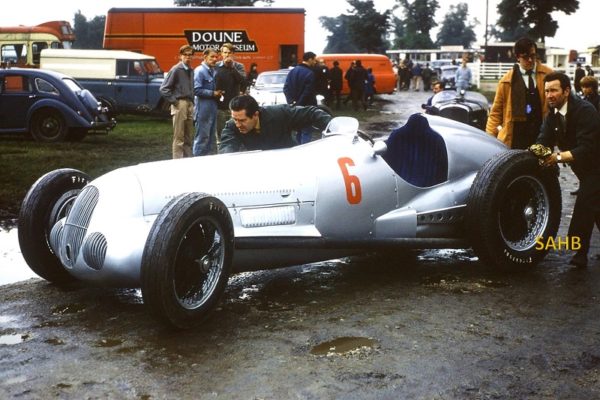
It is gratifying to know that the former owner and racer of this Mercedes-Benz ‘Silver Arrow’ racing car is still with us, having recently published his autobiography. The man in question, and (we think) the tall, imposing figure watching his mechanics prepare his car for the start of the race, is Colin Crabbe – the racing driver, and collector of and dealer in historic racing cars.
This snapshot was taken at the VSCC Oulton Park Meeting in June 1971, where Crabbe won the Richard Seaman Trophy race at the car’s first outing, demolishing the opposition of ERAs that had won for many of the previous years.
The car is Chassis 190815. It survived the War in what was to become Eastern Germany, and was the only one of the 9 cars built that was not retained by the factory. It was discovered in the 1960s near the Polish border by Colin Crabbe, who had to pay the staggering amount of $30,000 to get it across Checkpoint Charlie. Its radiator was missing, having been replaced by an ice-tank for short hill-climb work. Thousands of tiny needle rollers had to be sourced, as well as a new supercharger housing and many other parts.
After winning at Oulton Park in 1971, and again a year later, Crabbe sold the car to Neil Corner in 1973. Corner raced and demonstrated the car for many years until he sold it to Bernie Ecclestone. More recently it joined a German collection and was restored to full running order, and was one of the star attractions at the 2017 Goodwood Festival of Speed.
One of the most powerful racing cars of the pre-war era, the W125 developed 646 bhp at 5,800 rpm from a straight-eight twin-overhead-cam engine of 5,663 cc. To cope with this power, the engine had a Hirth crankshaft – a fiendishly complex device in which the connecting rods were solid, to remove the danger of failure of the usual two-part items, and the crankshaft was built up of interlocking segments with Hirth face-to-face zig-zag joints. It was said that the whole assembly made a dreadful rattling sound if all was well, but that if the engine suddenly became quiet and smooth, then it was about to seize and blow up!
The W125 is also well-known for one of the first re-introductions of the De Dion rear axle originally used on early De Dion-Bouton cars. The W125’s predecessor, the W25, was found by Mercedes-Benz’s engineer, Rudolf Uhlenhaut, to have a chassis that was too flexible and suspension that was too stiff, thus preventing the wheels from following the road effectively. Hence his brief for the new car: a stiffer chassis and suspension with more travel. The first was achieved by using oval tubes made of nickel-chrome molybdenum steel and the second by the De Dion axle – with the added advantage of low unsprung weight.
What our snapshot sadly cannot convey is the gorgeous smell from the car that your correspondent and photographer remembers after the win as the car cooled down in the Oulton Park paddock: a combination of methyl alcohol, benzene, ethyl alcohol and a mere 4% of petrol. Probably dangerous, possibly nowadays illegal, but a serious competitor for Castrol R as the best smell in vintage racing!







I remember seeing, hearing and smelling the car at the Oulton Park meetings in 1971 and 1972. In 1972 it rolled to a halt after crossing the finishing line with a wisp of smoke coming from the bonnet. That was the last time I saw it race. Does anyone know what happened to the car’s engine to cause it to be pulled up?
I was there in 1972 and I remember exactly what happened: he holed a piston, so the car won the race on only seven cylinders. But with over 600 bhp, what’s a cylinder between friends?